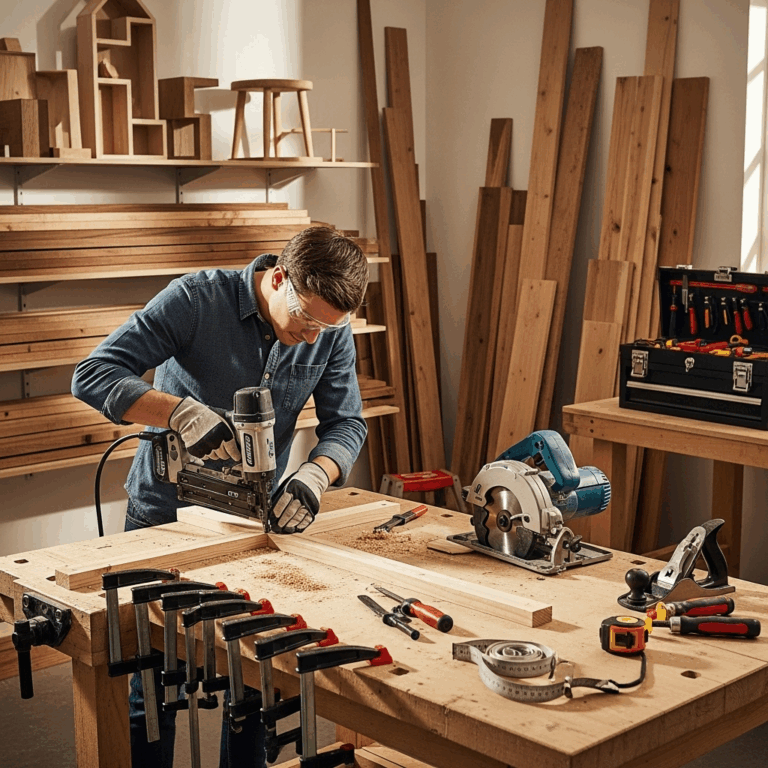Choosing your first nail gun doesn’t have to be complicated. This detailed buying guide breaks down nailer types, features, and essential factors to help you effortlessly select the perfect tool for your DIY projects. Get the right nailer the first time and build with confidence!
Ever stared at a wall of nail guns and felt completely overwhelmed? You’re not alone! Picking the right nailer for your DIY projects can seem tricky, especially when you’re just starting out. But it doesn’t have to be a headache. We’re going to walk through this together, step-by-step. You’ll learn what makes each type of nail gun tick and how to find the one that’s just right for you. Get ready to tackle those projects with a new tool that makes building easier and more fun!
Table of Contents
Your First Nail Gun: Making the Right Choice
Choosing your first nail gun is like picking the right hammer. It’s a foundational tool that can dramatically speed up your work and improve the finish quality. Whether you’re building a birdhouse, installing trim, framing a small shed, or even tackling a deck, there’s a nail gun designed to make the job smoother and faster than ever before. Forget messy glue-ups or struggling with a traditional hammer for every single nail.
The key is understanding the different types of nail guns and what they’re best used for. We’ll cover everything from the power source to the specific nail sizes they drive. By the end of this guide, you’ll know exactly what to look for to make an informed decision that fits your needs and budget.
Understanding Nail Gun Types: What’s the Difference?
Nail guns are primarily categorized by their power source and the type of nails they drive. This is the most important factor when deciding which one is right for you. Let’s break them down:
1. Pneumatic Nail Guns (Air-Powered)
These are powered by compressed air from an air compressor. They are often the most powerful and versatile, making them a top choice for professionals and serious DIYers.
- Pros:
- Powerful and fast
- Lightweight in hand (the tool itself, not the compressor)
- Reliable and durable
- Wide range of specialty nailers available
- Cons:
- Requires an air compressor (an additional purchase and takes up space)
- Hose management can be cumbersome
- Initial investment can be higher due to the compressor
2. Electric Nail Guns (Corded)
These plug directly into a wall outlet for power. They’re convenient if you have easy access to power and don’t want to deal with air compressors.
- Pros:
- No air compressor needed
- Consistent power as long as you have electricity
- Generally lighter and more compact than cordless options
- Cons:
- Limited by cord length and outlet availability
- Can be less powerful than pneumatic tools
- Motor can overheat with continuous heavy use
3. Cordless Electric Nail Guns (Battery-Powered)
These are powered by rechargeable batteries. They offer the ultimate in portability and convenience, eliminating the need for both cords and air compressors.
- Pros:
- Completely portable – no cords or air hoses
- Easy to set up and use anywhere
- Modern battery technology offers good power and runtime
- Cons:
- Heavier due to the battery pack
- Battery life can be a limitation for very long projects
- Can be more expensive upfront
- Power output might be slightly less than pneumatic for some tasks
4. Gas-Powered Nail Guns
These use a combination of a battery (to power the fan) and a disposable fuel cell (like propane or butane) to drive nails. They are often used in construction for framing and roofing where power isn’t readily available.
- Pros:
- Very portable, no cords or air hoses
- Good power for demanding tasks
- Fast firing rate
- Cons:
- Fuel cells need to be replaced, adding an ongoing cost
- Can emit fumes, requiring good ventilation
- Can be less reliable in very cold temperatures
- Maintenance can be more involved
Common Nail Gun Types by Project: Which One Do You Need?
Once you understand the power sources, it’s time to look at the specific types of nail guns, often named by the type and size of nails they fire. This is where you’ll find the perfect fit for your projects.
1. Brad Nailers
Brad nailers use slender, thin nails (typically 18-gauge) with a small head. They are perfect for delicate trim work, molding, and attaching small, lightweight pieces where minimal visibility of the nail head is desired.
- Common Uses: Crown molding, baseboards, window trim, furniture assembly, craft projects.
- Nail Size: Typically 18-gauge, with lengths from 5/8 inch to 2 inches.
- Recommended For Beginners: Yes, very versatile for interior finishing.
2. Finish Nailers
Finish nailers use slightly larger nails (typically 15 or 16-gauge) with a more substantial head than brad nails. They are ideal for attaching larger trim pieces, door frames, and cabinetry where a stronger hold is needed but you still want a small, easy-to-fill nail hole.
- Common Uses: Door casings, window frames, wainscoting, chair rails, heavier trim.
- Nail Size: Typically 15 or 16-gauge, with lengths from 1 inch to 2 ½ inches.
- Recommended For Beginners: Yes, a great all-around choice for interior finishing.
3. Framing Nailers
These are heavy-duty tools that use large, thick nails (often 2-inch to 3 ½-inch long). They are designed for structural work like building walls, framing roofs, and constructing decks. These are generally not for beginners doing light DIY.
- Common Uses: House framing, deck building, subflooring, fencing.
- Nail Size: Typically 8 to 13-gauge, with lengths from 2 inches to 3 ½ inches.
- Recommended For Beginners: Generally no, unless undertaking significant construction.
4. Roofing Nailers
Specialized for attaching shingles and underlayment to roofs. They have a deep-set nose for driving nails flush with the shingle surface and usually have a contact trip mechanism for rapid firing.
- Common Uses: Asphalt shingle installation, roofing felt.
- Nail Size: Typically 1-inch to 1 ¾-inch roofing nails.
- Recommended For Beginners: No, a very specialized tool for a specific job.
5. Pin Nailers (or Micro Pin Nailers)
These use extremely thin, headless or nearly headless pins (23-gauge). They leave virtually invisible holes and are used for delicate projects where precision and aesthetics are paramount, like attaching small moldings or securing pieces while glue dries without marring the surface.
- Common Uses: Very fine trim, delicate craft work, securing small parts, tacking in place while glue dries.
- Nail Size: Typically 23-gauge, with lengths from ½ inch to 1 ¼ inches.
- Recommended For Beginners: Yes, for hobbyists or very fine detail work.
6. Flooring Nailers
Designed specifically for installing hardwood or engineered wood flooring. They usually drive through the tongue of the flooring plank at an angle. Some are manual, others pneumatic. They can also be combined with a stapler.
- Common Uses: Hardwood, engineered wood flooring installation.
- Nail Size: Specialized flooring nails.
- Recommended For Beginners: No, unless undertaking a dedicated flooring project.
Key Features to Consider When Buying
Beyond the type and power source, several features can make a big difference in your nail gun experience. Think about how you’ll use the tool and what will make your jobs easier and safer.
1. Depth Adjustment
This is crucial! It allows you to control how deep the nail is driven into the material. You’ll want to be able to sink nails flush with the surface for trim or slightly below the surface (countersunk) for finishing, all without damaging the wood. Most nail guns have some form of depth adjustment, but look for one that’s easy to access and adjust.
2. Firing Mode (Sequential vs. Contact Actuation)
This controls how the nail gun fires. It’s a safety feature and impacts speed.
- Sequential Mode: You must intentionally trigger the tool (pull the trigger) AND press the nose of the gun against the workpiece. This prevents accidental firing and is the safer option for most applications, especially when precision is needed.
- Contact Actuation (Bump Fire): You can fire nails by simply holding down the trigger and bumping the nose of the gun against the workpiece. This allows for rapid firing but carries a higher risk of accidental discharge, so it requires more caution. Many nail guns offer a switch to toggle between these modes, which is ideal.
For beginners, always start with sequential mode until you are completely comfortable. Learning more about tool safety is always a good idea. The Occupational Safety and Health Administration (OSHA) has excellent resources on power tool safety.
3. No-Mar Pad
A soft rubber or plastic tip on the nose of the nail gun. This protects delicate work surfaces (like finished wood or laminate) from the metal tip of the gun, preventing dents or scratches. Essential for fine woodworking and trim.
4. Ergonomics and Weight
You’ll be holding this tool, so comfort is important. Check the grip design, balance, and overall weight. A tool that’s too heavy or awkward can lead to fatigue and less accurate work. Try to hold one in a store if possible, or read reviews focusing on comfort.
5. Magazine Capacity and Loading
The magazine holds the nails. Higher capacity means fewer reloads, which speeds things up. Loading should be straightforward and easy. Some magazines are top-loading, while others are bottom-loading. Consider which you find easier.
6. Air Fittings (for Pneumatic)
If you’re going pneumatic, ensure the nail gun comes with the correct air fitting, usually a 1/4-inch NPT (National Pipe Thread). You’ll also need to match this to your air compressor’s quick-connect coupler.
7. Tool Maintenance
Most nail guns require occasional lubrication (for pneumatic) or cleaning. Read reviews and check the manufacturer’s recommendations for maintenance. Simple maintenance ensures a longer tool life and consistent performance.
Putting It All Together: Choosing Your First Nail Gun
Let’s simplify the decision-making process. Based on typical beginner projects, here’s a likely scenario:
Scenario 1: You primarily do interior trim, molding, and light furniture assembly.
- Recommendation: A cordless electric or pneumatic 16-gauge finish nailer is probably your best bet.
- Why:
- 16-gauge nails offer a good balance of holding power and a relatively small, easy-to-conceal nail head.
- Cordless electric offers ultimate portability if you don’t have an air compressor.
- Pneumatic offers consistent power and a lighter tool weight in hand if you’re willing to invest in or already own an air compressor.
- Look for: Easy depth adjustment, sequential firing mode, and a no-mar tip.
Scenario 2: You’re building small projects like shelves, simple cabinets, or craft items.
- Recommendation: A cordless electric or pneumatic 18-gauge brad nailer.
- Why:
- 18-gauge nails are slender, leave smaller holes, and are perfect for holding lighter pieces together.
- Brad nailers are generally more affordable and easier to handle than larger nailers.
- Look for: Adjustable depth and a no-mar tip.
Scenario 3: You’re tackling bigger projects like decks, sheds, or serious furniture building.
- Recommendation: You might need more than one tool. A pneumatic 15-gauge finish nailer for trim, and a pneumatic framing nailer for structural elements.
- Why: Framing nailers are specifically designed for strength and speed on structural lumber.
- Look for: Robust construction, reliable performance, and safety features.
Essential Accessories and Safety Gear
Don’t forget the things that go along with your nail gun! They’re just as important as the tool itself.
1. Nails (Fasteners)
Always use the correct type and size of nails specified by the nail gun manufacturer. Using the wrong nails can cause jams, damage the tool, or lead to poor results. For example, you cannot use brad nails in a finish nailer. Check the gauge and collation type (e.g., straight, offset, angled).
2. Air Compressor (for Pneumatic)
If you choose a pneumatic nailer, you’ll need an air compressor. For most DIY nail guns (brad, finish), a small pancake or hotdog style compressor (2-6 gallon capacity, around 1-2 CFM at 90 PSI) will suffice. For framing or roofing nailers, you might need a larger compressor.
3. Air Hose and Fittings
A flexible air hose (often 25-50 feet is plenty for DIY) and the correct quick-connect fittings to attach it to your nailer and compressor. Consider an oil-lubricated vs. oil-free compressor; oil-free is lower maintenance but can be louder.
4. Battery and Charger (for Cordless)
If you buy a cordless tool, ensure it comes with at least one battery and a charger. Consider purchasing an extra battery if you plan on extended use without access to power.
5. Safety Glasses
This is non-negotiable. Always wear safety glasses or goggles that meet ANSI Z87.1 standards to protect your eyes from flying debris or ejected fasteners. The National Institute for Occupational Safety and Health (NIOSH) emphasizes the importance of eye protection in preventing workplace injuries.
6. Hearing Protection
Some nail guns, especially pneumatic ones, can be loud. Earplugs or earmuffs are a good idea for prolonged use.
7. Work Gloves
To improve grip and protect your hands from splinters or minor abrasions.
A Comparison of Popular Nail Gun Types for DIYers
To help visualize the choices, here’s a table comparing the suitability of different nail gun types for common DIY tasks:
| Nail Gun Type | Ideal for DIY Tasks | Power Source Options | Pros for DIYers | Cons for DIYers |
|---|---|---|---|---|
| 18-Gauge Brad Nailer | Interior trim, molding, small furniture, craft projects, attaching thin materials. | Pneumatic, Electric, Cordless Electric | Small nail size, minimal damage, affordable, lightweight. Great for delicate work. | Not strong enough for structural tasks. May require more nails. |
| 16-Gauge Finish Nailer | Door/window trim, baseboards, chair rails, cabinet installation, heavier trim. | Pneumatic, Cordless Electric | Good holding power, small nail head for easy filling, versatile for interior finishing. | Larger nail hole than brad nailer. Not for very fine detail. |
| 15-Gauge Finish Nailer | Similar to 16-gauge but provides more holding power. Good for hardwoods and heavier trim. | Pneumatic, Cordless Electric | Stronger hold than 16-gauge, good for demanding trim work. | Slight |



